Organisms that have a nucleus enclosed within a nuclear envelope. Consists of visible and multi-cellular organisms.
Unicellular organisms that live in extreme environments and lack peptidoglycan in their cell walls.
Single-celled microscopic organisms present everywhere on Earth.
Multicellular organisms that have cell walls made of cellulose in their cells. This helps them go through photosynthesis where the chlorophyll in them helps store sunlight and convert it into a source of energy for the plant. Terrestrial plants are thought to have evolved from aquatic green algae, which are plant-like protists that have adapted to live on land.
The Arthropods are a more complex version of the Annelida's after they go through macroevolution. These organisms have a hard exoskeleton made of chitin and protein and posses many jointed appendages with a segmented body. Those are the most visible evolutionary trends that help out-group the Arthropods from the rest of the phylas.
The Annelida phyla is more complex than the Nematoda phyla because these organisms possess both a complete digestive system, and an advanced nervous system. These segmented worms have a true coelom unlike the Nematoda's which consist of a false coelom. After the Nematoda's go through macroevolution, the Annelida's become the most advanced species of worms.
The Nematoda's are an evolved version of the Platyhelminthes with organs in their body cavity and a complete digestive tract. They are unsegmented worms that are also bilaterally symmetrical. They are important parasites of humans and animals.
Platyhelminthes have three germ layers, endoderm, ectoderm, and mesoderm. They are the simplest free-living organisms that have a flat, bilaterally symmetrical body with a head and a tail. They have no circulatory system or hard skeleton which makes them unique compared to the organisms in the rest of the phylas. The evolutionary trend is when the ectoderm develops into the body covering. The mesoderm develops into an internal tissue and the endoderm develops into the digestive sac.
The main evolutionary trend of the Mollusca phyla is when the mesoderm develops from pockets of endoderm. The deuterostome is where the opening turns into the mouth. In these animals, the second opening is the mouth while the first opening is the anus in contrast with humans, where the first opening is the mouth and the second is the anus.
The Echinodermata phyla differs from the Mollusca phyla because it has a coelom, whereas, the Mollusca has a hemocoel. Organisms in this phyla closely relate to the Chordatas and are much more complex than Mollusca. They evolved from bilaterally symmetric organisms and show radial symmetry (symmetry around the central axis). Generally live in shallow water.
The Chordates are the most complex group of animals. Have the most complex brains and nervous systems. Evolved from the echinoderms phyla and now possess a post-anal tail, a notochord, a dorsal, hollow nerve cord, and gill slits.
Unlike the Porifera's, the Cnidaria's are gastrovascular, have a digestive system, and 2 tissue layers, making them more complex than Porifera's. However, they are still considered the most simple organisms at the tissue grade of organization. They also possess Cnidocytes (stinging cells) and Nematocysts (prickly barbs).
Most simple multicellular organisms that lack true tissue and organs unlike the rest of the animals. These sponges are out-grouped from the rest of the phyla's because of its unique feeding system, cellular digestion(heterotrophic). Has no mouth, digestive, nervous system, or muscles.
Heterotrophic multicellular organisms who's cells do not have cell walls unlike organisms in the rest of the kingdoms. Animals Also have nerve and muscle tissue which helps them perform and move unlike plants and fungi.
Eukaryotic and heterotrophic organisms that reproduce using spores. They can be unicellular or multicellular.
Absorb food from surrounding water or soil. Can also invade the body of another organism to feed. Play a major role in decomposition.
Have one or two flagella. Feed on living and decaying matter. Reproduce using spores.
One large bag of cytoplasm with many nuclei. Forms spores for reproduction in unfavourable conditions.
Help recycle organic material. Found on forest floors or backyard compost pile. Feed on dead plants, bacteria, yeast, and fungi.
Molds that are absorptive feeders, found on decaying matter. Are heterotrophs that have cell walls and reproduce by forming spores.
Called Algae. Contain chlorophyll and carry out photosyntheses. Live in wet/moist environments.
Do not move on their own and are parasitic
Move using 1 or 2 flagella
Move and gather food using cilia
Move and feed using pseudopods, can change shape
Called Protozoa. Are heterotrophic and unicellular. Reproduce via binary fusion.
Have a nucleus and survive better in aquatic environments. Reproduce asexually and sexually. They can also be parasites.
Single-celled microscopic organisms similar to bacteria, except they live in extreme environments such as water and soil.
Prokaryotic unicellular organisms that have peptidoglycan in their cell walls. Lacks a membrane-enclosed nucleus.
Three Domains of Life
Eukarya
Plantae
Angiosperms
Angiosperms, also known as flowering plants, reproduce through flowers and fruits. The main evolutionary trend here is that they posses small pollen grains or ovules that spread to other flowers, male to female, resulting in the production of more flowers. They have co-evolved with insects to improve their lives on land using seed dispersal. This method is called pollination and can be done by the wind, water, or an animal.
Ex. Flowering plants
Gymnosperms
Gymnosperms are cone-bearing seed plants that have vascular tissue. Conifers differ from Mosses and Ferns because they reproduce using seeds, not spores. These organisms are mostly woody plants or trees. In order for this organism to reproduce by dispersing seeds, it has adapted to live on land.
Ex.Conifers
Seedless vascular
Ferns are the result of microevolution that took place with the Mosses. Ferns are vascular plants that also reproduce using spores, whereas, Mosses are non-vascular. Since vascular plants have vessels to transport food and water, this makes them more successful to live life on land.
Ex.Ferns
Byrophates
A non-vascular plant that produces spores for reproduction. It has thought to have evolved from green algae. It is a flowerless plant that has rhizoids to help it absorb nutrients instead of roots.
Ex.Mosses
Animalia
Platyhelminthes
Ex. Flatworm
Cnidaria
Ex. jelly fish
Chordata
Vertebrate
Ex. Vertebrates
Mammals
Ex.Elephant
Fish
Ex.Shark
Reptiles
Ex.fish
Amphibians
Ex.frog
Echinodermata
Ex. Sea Star
Arthropoda
Myriapoda
Myriapods's have a pair of antenna as well as a pair of mandibles. The difference with this species is that it has two pairs of maxillae whereas, most millipedes only have one pair of maxillae consisting of up to 200 legs (this means up to 400 legs for the Myriapods).
Ex.Myriapoda
Chelicerate
Unlike the rest of the Arthropods, the Chelicerates don't posses an antenna or mandibles. This organism has six pairs of appendages.
Ez.Leviathan
Hexapoda
The biggest elementary trend with the Hexapods is one pair of antenna, and three pairs of walking legs (6 legs), which helps this organism practice its movement better since the rest of the Arthropods only consist of 3 legs.
Ex.Beetles
Crustacea
They are characterized by having mandibles and compound eyes, biramous appendages. Live in mostly aquatic habitats. Crustacea's evolved from the Annelid worms to a crab-like body structure with a stronger skeleton.
Ex.Crabs
Annelida
Ex. Earthworm
Nematoda
Ex. Roundworms
Porifera
Ex. sponges
Mollusca
Ex. snails
Fungi
Deuteromycota
Reproductive strategy: reproduce asexually by producing asexual conidiospores.
Ex. Parasitic fungi
Basidiomycota
Reproductive strategy: reproduce sexually through the formation of specialized club-shaped end cells called basidia.
Ex. Mushrooms
Ascomycota
Reproductive strategy: reproduce asexually through budding or the formation of conidia.
Ex. yeast
Zygomycota
Reproductive strategy: reproduce asexually through the formation of spores.
Ex. zygomycota
Protista
Plant-like
Pyrrophyta
Ex. Gonyaulax
Chrysophyta
Ex. Cyclotella
Chlorophyta
Ex. Ulva
Rhodophyta
Ex. Porphyra
Phaeophyta
Ex. Macrocystis
Euglenophyta
Ex. Euglena
Fungus-like
Water Moulds
Oomycota
Ex. Oomycota water mould
Chytridiomycota
Ex. Chytridiomycota water mould
Slime Moulds
Plasmodial
Ex. plasmodial slime mould
Cellular
Ex. cellular slime mould
Animal-like
Sporoza
Ex. Plasmodium
Flagellates
Ex. Leishmania
Ciliates
Ex. Paramecium
Cercazoans
Ex. amoeba
Archaea
Archaebacteria
Methanogens
Ex. Methanogens
Halophiles
Ex. Halophiles
Thermophiles
Ex. Thermophiles
Bacteria
Eubacteria
Coccus
Ex. coccus shaped eubacteria
Sprillum
Ex. Sprillum shaped eubacteria
Bacillus
Ex. Bacillus shaped eubacteria









